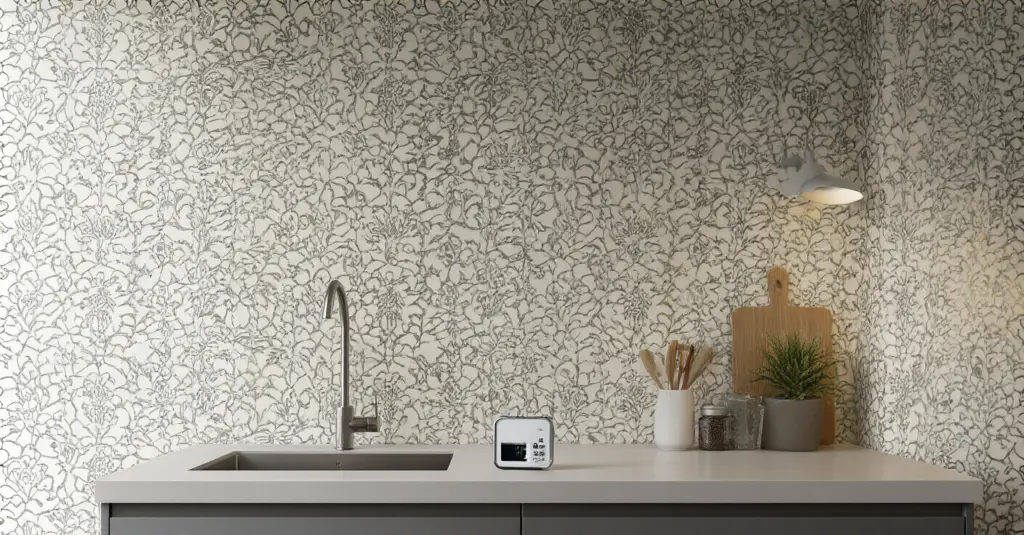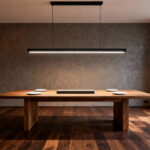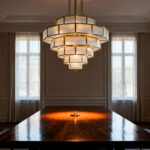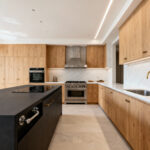Can we talk about why everyone gets kitchen walls so wrong? There’s this strange, persistent idea that the kitchen needs to be a purely utilitarian, sterile space—all tile, steel, and semi-gloss paint. It’s an artistic crime, frankly. A kitchen is the heart of the home, a place of creation, conversation, and chaos. To leave its walls blank is to miss the single greatest opportunity to install a monumental piece of art you can live inside every single day.
When I talk about modern kitchen wallpaper, I’m not talking about your grandmother’s peeling floral borders. I’m talking about turning your walls into a canvas. I’ve spent years in galleries watching how a single powerful artwork can command a room, and I’ve learned that the same principle applies right where you make your morning coffee. This isn’t about just covering a wall; it’s about curating an experience. Forget the corporate-speak and the endless, confusing options online. Let’s talk about what actually matters.
Foundations for a Flawless Kitchen Wallpaper Project (Part 1)
Before you even think about patterns or colors, you have to prepare the gallery. And by gallery, I mean your kitchen. This is the part everyone wants to skip, and it’s the single most important stage. A masterpiece hung on a crumbling wall is still a masterpiece on a crumbling wall—and it’s not going to stay up for long. This is the groundwork that separates a stunning installation from a DIY disaster.
1. Assessing Kitchen Conditions: Moisture, Heat, and Lighting
You wouldn’t hang a priceless watercolor in a steamy bathroom, right? The same logic applies here. Your kitchen is a battlefield of steam from boiling pasta, heat from the oven, and the occasional splash of grease. These aren’t enemies of wallpaper; they’re just environmental factors you have to respect. Walk through your space like a curator planning an exhibition. Notice which wall gets the most splatters from the sink or stove. Does the wall behind the coffee maker get a daily dose of steam?
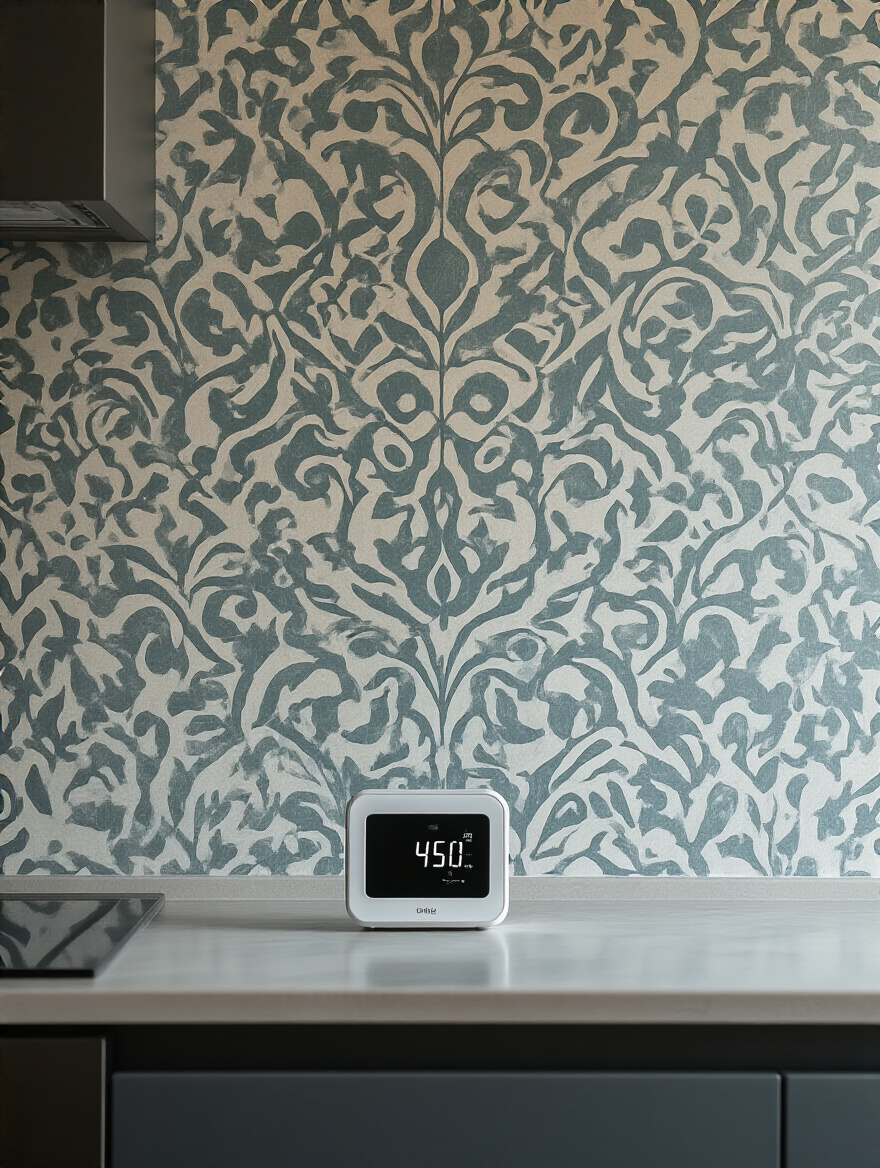
The noise is all about fancy hygrometers and specific humidity percentages. What actually matters is using your common sense. The real story is that heat and moisture will attack the adhesive first, causing the paper to lift at the seams. So, for those “hot zones”—behind the stove, sink, or dishwasher—you need to choose a material that can take a beating. Don’t fall in love with a delicate, unsealed paper and expect it to survive behind your faucet. It’s just not going to happen.
Now that you’ve surveyed the landscape and know what your walls have to endure, we can start talking about the soul of the project: the story you want to tell.
2. Defining Your Modern Aesthetic: Minimalism, Industrial, or Eclectic
Okay, forget those rigid design “boxes” for a second. Let’s talk about the feeling. When you walk into your kitchen, how do you want to feel? Energized and creative? Calm and focused? Wrapped in a cozy, eclectic hug? That feeling is your aesthetic. It’s not about whether you’re “minimalist” or “industrial”; it’s about the story your space tells. Your wallpaper is the narrator of that story. If your cabinets are sleek and handleless, maybe a textured, fabric-like paper can add a layer of softness and warmth. That’s your minimalist story.
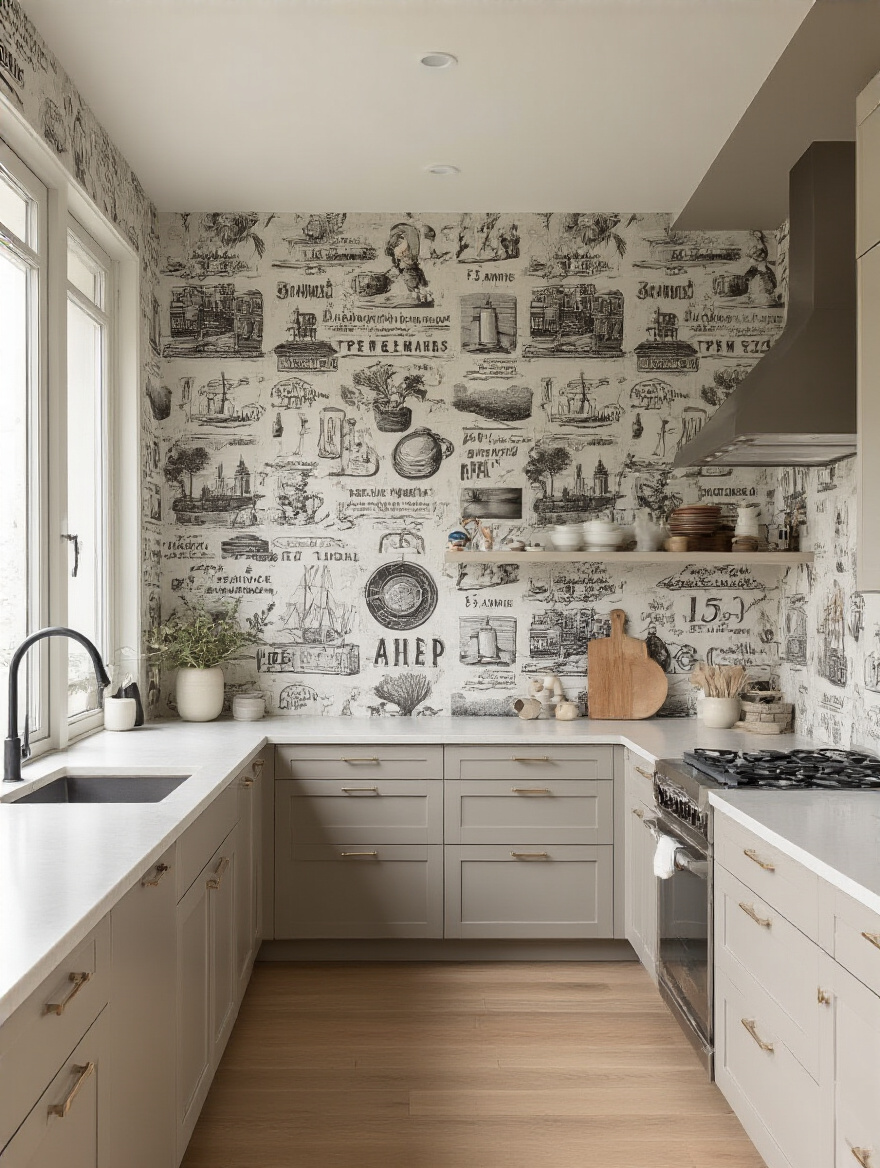
A client of mine had this incredible loft with exposed brick and steel beams. She thought she had to stick to a cold, industrial look. I asked her what she loved, and she pulled out a photo of a lush, overgrown greenhouse. We found a bold, large-scale botanical print—dark, moody, and full of life. We put it on one huge wall, and it completely transformed the space. It didn’t fight the industrial elements; it gave them a soul. Everyone says you have to pick one style and stick with it. That’s BS. The best spaces tell a story of contrast and personality.
This story you’ve chosen needs a stage. Not every wall is created equal, so let’s think like a curator and decide where the masterpiece will truly shine.
3. Strategic Placement: Accent Walls vs. Full Room Coverage
You know what people always ask me? “Should I do an accent wall, or wallpaper the whole room?” There’s no right answer, only a strategic one. Think of it like this: an accent wall is a statement piece of art. Full-room coverage is an immersive installation. Neither is better, they just have different goals. An accent wall is perfect for creating a focal point in a space that lacks one. The wall behind your breakfast nook? The back wall of a pantry? Behind a set of open shelves? These are all brilliant stages for a bold, powerful print.
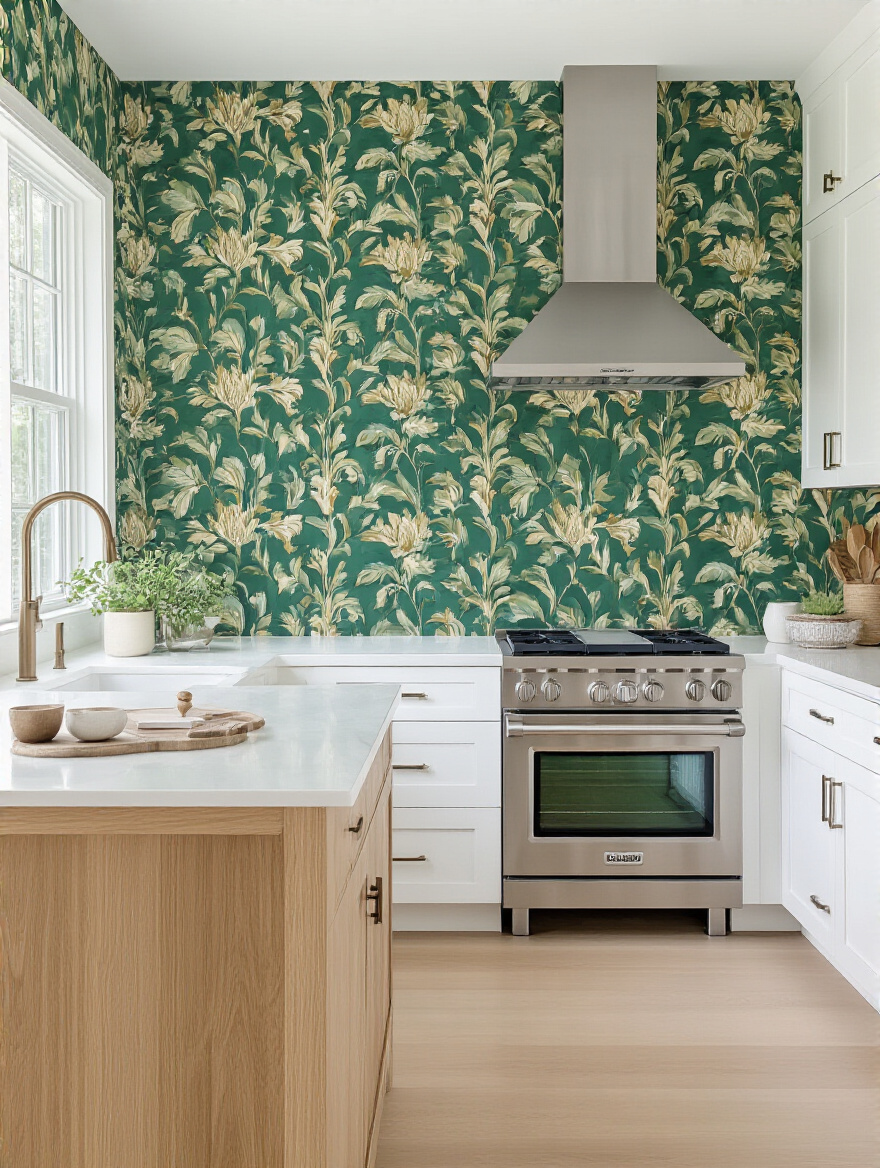
But if you want to create a truly enveloping mood, full-room coverage can be magical, especially in a small space. Everyone says a bold pattern in a small room will make it feel smaller. That’s not always true. What it actually does is blur the corners and create a sense of depth, turning a boring little box into a jewel box. I once worked on a tiny galley kitchen with no windows. We wrapped the whole thing—walls and ceiling—in a gorgeous, dark navy paper with a subtle gold geometric pattern. Instead of feeling cramped, it felt intimate, sophisticated, and infinite. The trick is to commit.
Whether you’re creating a moment or an entire mood, the success of your vision hinges entirely on the physical material you choose. It’s time to select your medium.
4. Material Matters: Vinyl, Non-Woven, and Peel-and-Stick Options
Let’s cut through the noise. There are really only three categories you need to care about, and each is like a different artistic medium. Solid vinyl is your durable oil painting. It’s scrubbable, tough as nails, and laughs in the face of moisture. This is your go-to for behind the sink or any high-traffic, high-splash zone. Non-woven wallpapers are more like a high-quality acrylic paint—breathable, a bit more delicate, but with a beautiful, high-end matte finish. They are easier to install and remove than old-school papers.
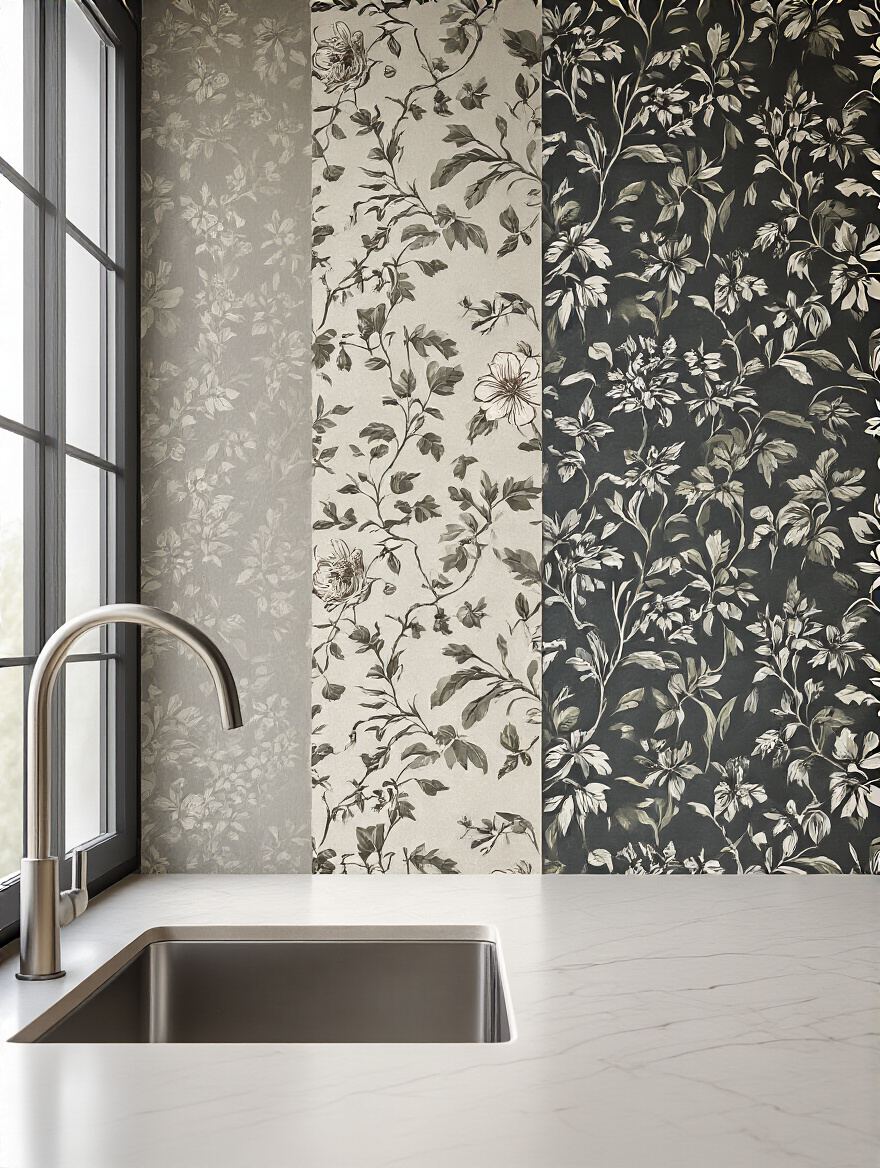
Then there’s peel-and-stick, the brilliant watercolor sketch of the wallpaper world. And here’s where I need to call out some BS. Everyone thinks peel-and-stick is cheap, flimsy, and just for renters. Not true anymore. High-quality peel-and-stick wallpapers are now made from fantastic vinyl or woven fabrics, and their adhesives are incredibly strong yet removable. I used a stunning peel-and-stick mural from an artist on Etsy for a client’s dining area. Two years later, it looks flawless, and they love knowing they can change it without a massive ordeal. It’s the ultimate shortcut to a huge transformation without total commitment.
Foundations for a Flawless Kitchen Wallpaper Project (Part 2)
Art has a price, and so does installing it. This part isn’t as sexy as picking out a pattern, but ignoring it is the fastest way to turn your dream project into a stressful nightmare. We need to talk honestly about what this is going to cost, beyond just the price of the rolls.
5. Budgeting Smartly for Wallpaper and Installation Costs
I once watched a client fall in love with a breathtaking, hand-painted wallpaper that was $400 a roll. She bought just enough to cover the wall, according to her measurements. Then the installer made one wrong cut trying to match the pattern. They were one strip short. The company had sold out of that dye lot, and the new batch didn’t match perfectly. She ended up having to buy all new paper. The shortcut she tried to take—not buying the extra roll—cost her thousands.
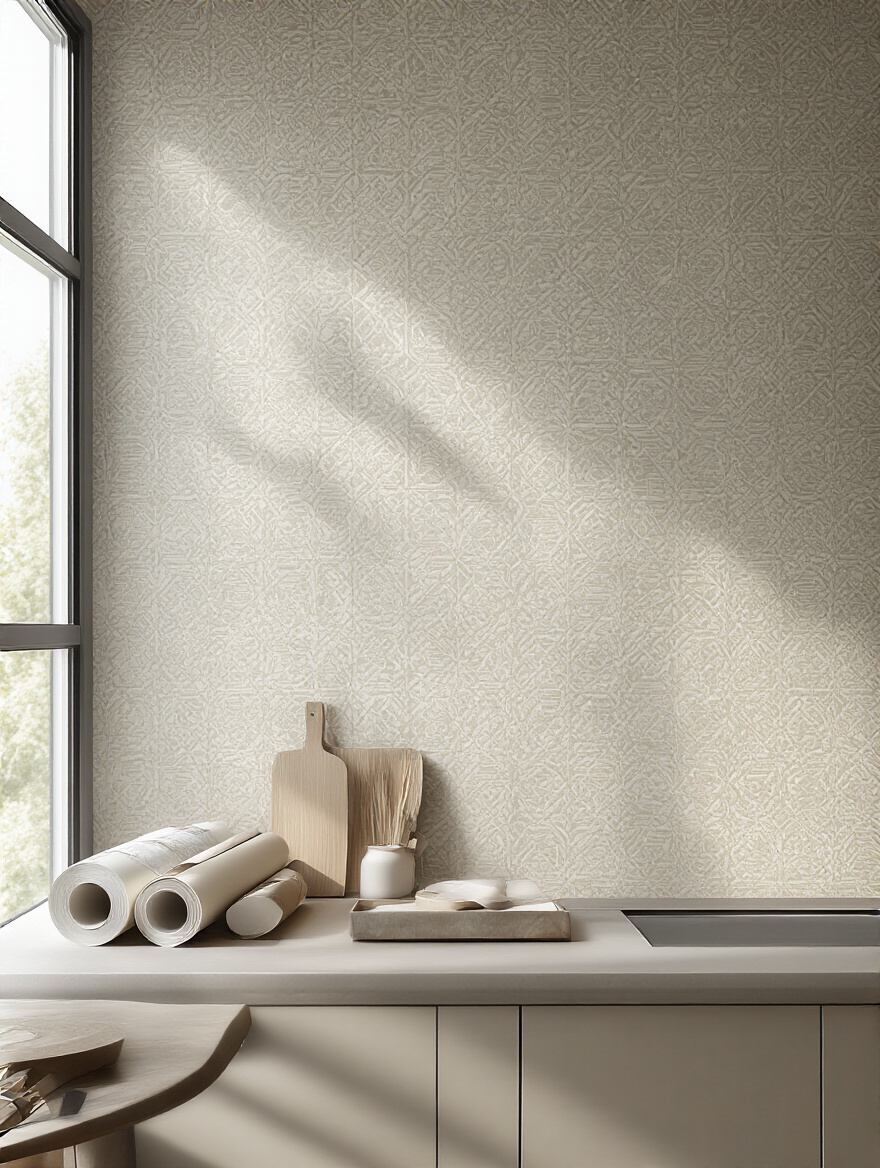
Your real budget isn’t just the cost of the wallpaper. It’s the wallpaper, plus 15% extra for mistakes and pattern matching (that’s your insurance policy). It’s the cost of a good primer, the right adhesive (don’t cheap out on this!), and maybe a few new tools. If you’re hiring a professional—which I strongly recommend for expensive papers or tricky walls—get at least three quotes. And ask them if wall prep is included. That’s the “hidden fee” that gets everyone. A smart budget has a line item for the art, and a line item for the “gallery prep.”
Choosing and Installing Your Modern Kitchen Wallpaper (Part 1)
This is where the real fun begins—the moment you move from planning to creating. You’re selecting the colors, the patterns, the very energy of the room. This phase is about trusting your eye, but also being incredibly precise. It’s a dance between the artist and the engineer.
6. Navigating Patterns and Prints: Geometrics, Botanicals, and Textures
Choosing a pattern isn’t just about what looks pretty on a website. It’s about scale and rhythm. A large-scale botanical print can feel lush and expansive, but in a tiny kitchen with lots of cabinets breaking up the wall, the pattern might get lost and just look chaotic. A small, tight geometric, on the other hand, can read as a texture from far away and feel modern and orderly. My advice? Get samples. Big ones. Tape them to the wall and live with them for a few days.
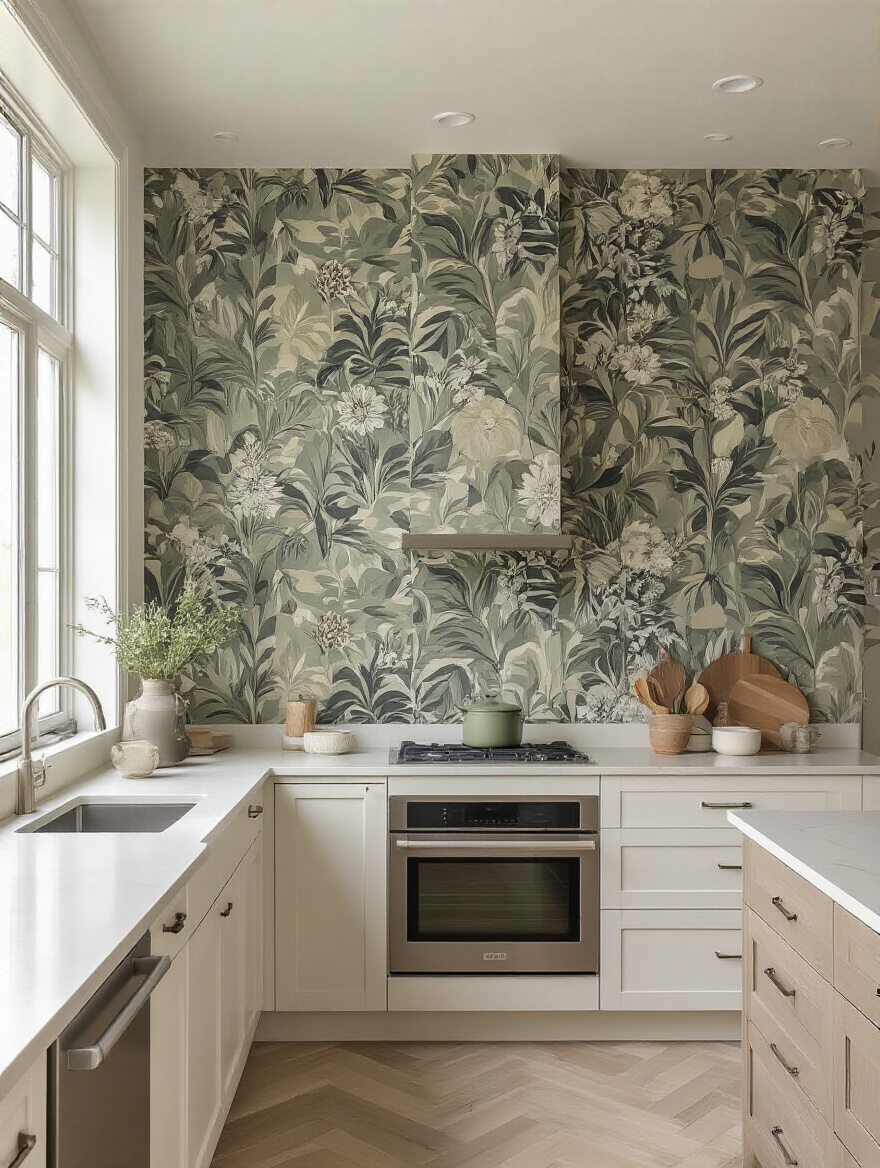
See how the pattern looks in the morning light when you’re making coffee, and in the evening under artificial light. Does it make you happy? Does it energize you? One thing I’ve learned is that patterns with a strong vertical line will make your ceilings feel higher. Patterns with horizontal movement can make a narrow room feel wider. Don’t just look at the print; think about what it’s doing to the architecture of your space. It’s a powerful illusion you can control.
The shapes and lines of your pattern are important, but their emotional impact is almost entirely dictated by color.
7. Understanding color psychology: Creating Moods with Kitchen Wallpaper
I used to think color psychology was a bit fluffy. Then I spent a year working on an exhibition of Mark Rothko’s paintings, and I saw firsthand how a massive field of deep red could make people feel anxious and claustrophobic, while a block of serene blue could make them visibly relax. Color is pure emotion, and it’s the most powerful tool you have. In a kitchen, you want to think about the energy you’re creating. Do you want a calm, peaceful space? Look at soft blues, greens, and muted earth tones.
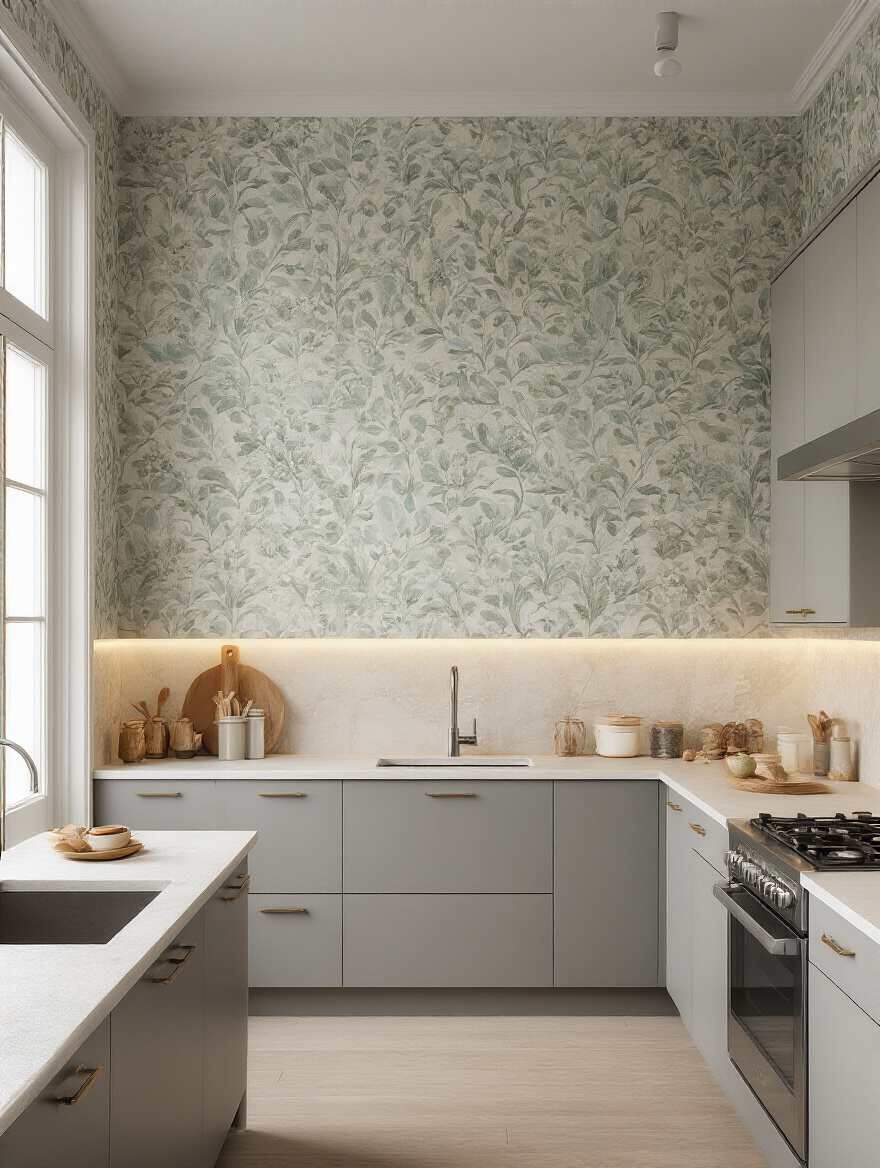
If your kitchen is the central hub for morning chaos and getting everyone out the door, maybe you want something that screams energy. Warm yellows, vibrant corals, or even a shot of bold red can be incredibly stimulating and appetite-inducing. A client once chose a bright yellow lemon-print wallpaper for her tiny, dark kitchen. Everyone told her it was “too much.” But you know what? It felt like sunshine every single morning, and she said it completely changed how she felt about starting her day. Trust your gut. How do you want to feel at 7 a.m. on a Tuesday? Pick that color.
Once you’ve settled on the perfect emotional tone and pattern, it’s time to get ruthlessly practical. Mis-measuring is an artist’s cardinal sin.
8. Accurate Measurement Techniques to Minimize Waste
I’m going to give you the only shortcut that matters: Measure every wall’s height and width. Multiply them to get your square footage. Then, look at the square footage on the wallpaper roll. Divide your wall area by the roll area. Round up. And then add one entire extra roll to your cart. No exceptions. This isn’t a suggestion; it’s the rule.
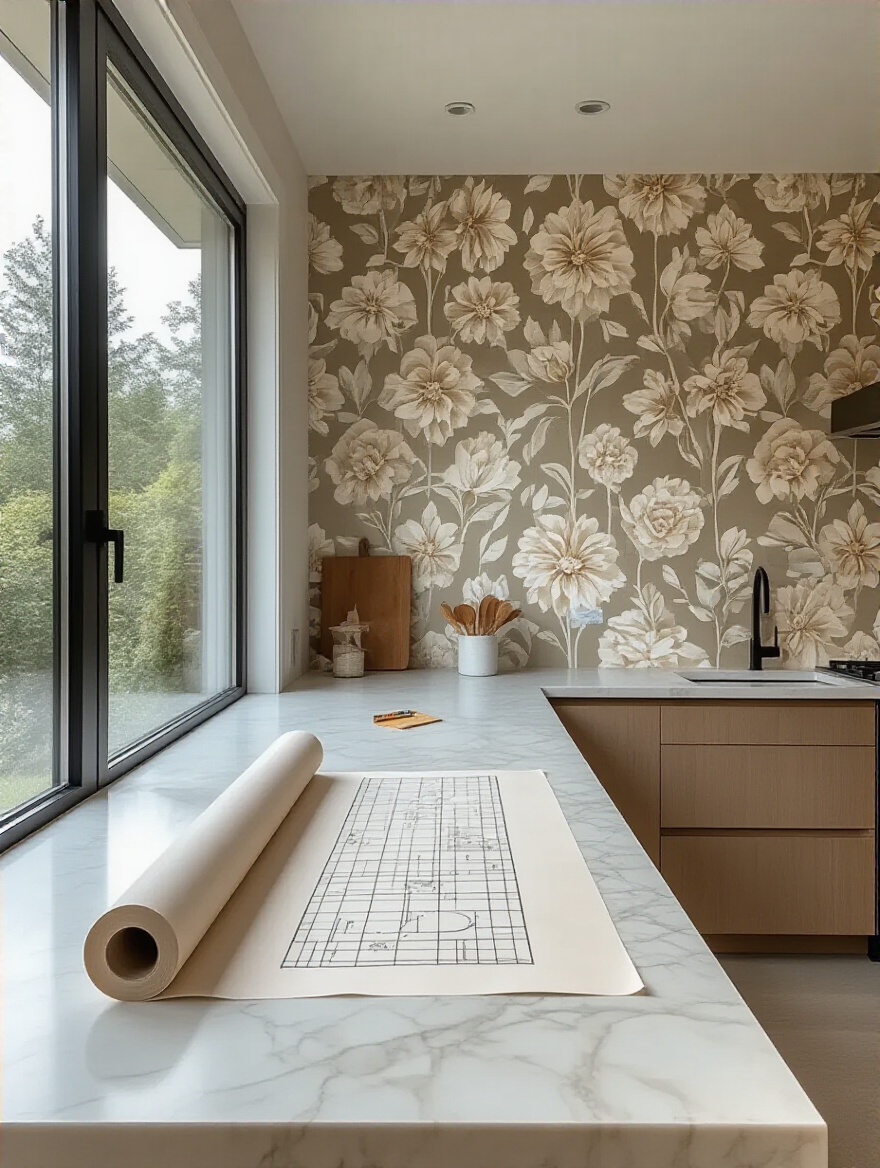
That extra roll is your get-out-of-jail-free card. It’s for when you realize your walls are crooked (they all are). It’s for when the pattern repeat is larger than you thought and you lose six inches on every strip. It’s for when you have to patch a small tear a year from now. Trying to save money by not buying that extra roll is the most expensive mistake you can make. The noise is all about complicated wallpaper calculators and formulas. The real story is: buy one more roll than you think you need. End of story.
The final big decision in this phase is about ego. Are you capable of doing this yourself, or do you need to bring in a master craftsperson?
9. DIY vs. Professional Installation: Weighing Pros and Cons
I am a huge believer in the power of DIY, but I’m also a realist. So here’s the deal. Are you planning to use a forgiving peel-and-stick wallpaper on one simple, flat accent wall with no outlets or windows? You can probably do this. Go for it. It’s incredibly satisfying. Are you planning to install a traditional, unpasted, high-end paper with a complex pattern repeat in a room full of weird angles, windows, and cabinets? For the love of all that is holy, hire a professional.
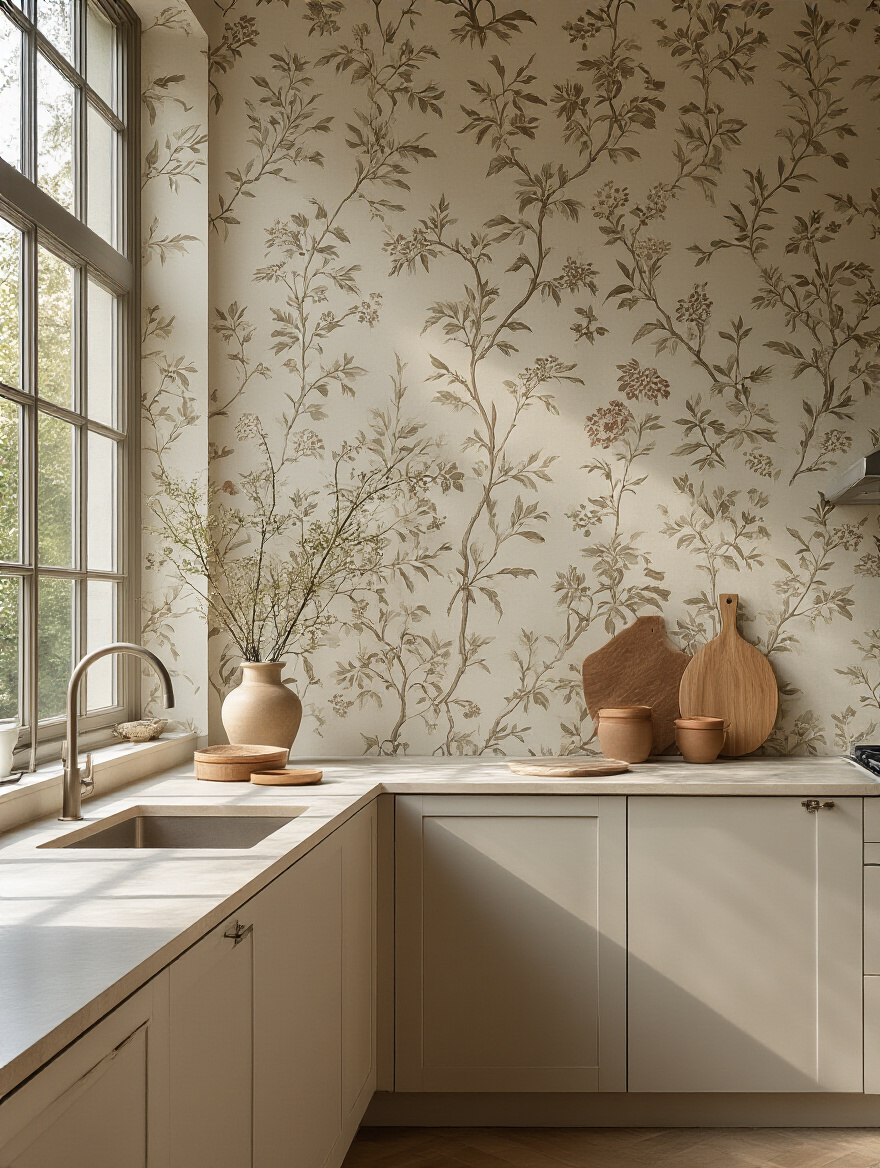
A pro installer isn’t just hanging paper; they’re a magician. They know how to prep walls you didn’t even know needed prepping. They know how to make seams completely vanish. They know how to hang paper so it’s perfectly plumb even when your house is leaning three degrees to the left. The money you spend on a great installer is an investment in making your wallpaper—your art—look as good as it possibly can for as long as it possibly can. Trying to DIY a complex job will just lead to frustration, waste, and a finish you’ll never be truly happy with.
Choosing and Installing Your Modern Kitchen Wallpaper (Part 2)
Whether you’ve hired a pro or are bravely taking on the challenge yourself, the moment of application is here. But before a single piece of paper goes up, the canvas must be prepared. This is where patience pays off tenfold.
10. Essential Tools and Preparation for a Seamless Application
Let’s keep this simple. You don’t need a thousand fancy tools. You need a clean, smooth wall. You need a high-quality primer. And you need a terrifyingly sharp utility knife with lots of extra blades. That’s 90% of the battle. The single biggest mistake people make is skipping the primer. They think, “The wall looks fine, I’ll just hang the paper.” This is a fatal error, especially in a kitchen.
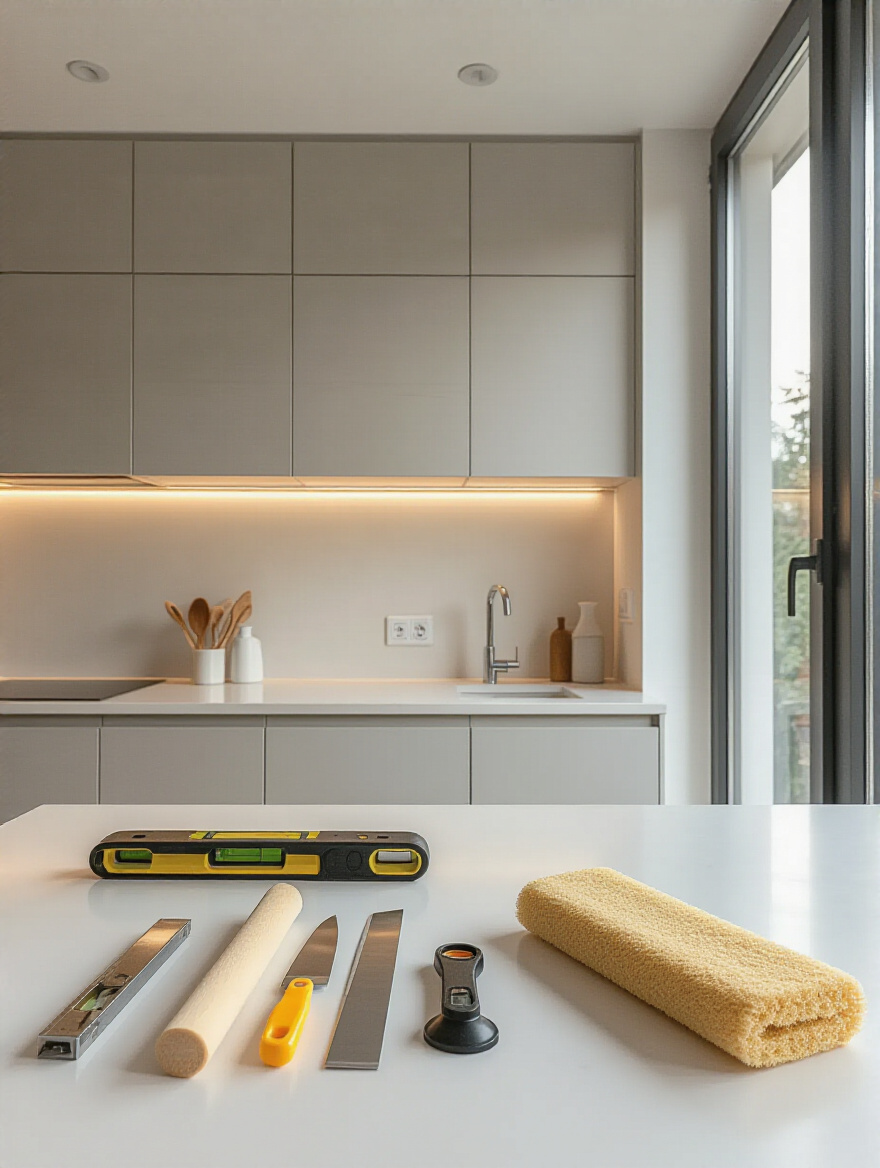
Primer is the gesso for your wall canvas. It seals the drywall so it doesn’t soak up all the adhesive. It creates a uniform surface that the wallpaper can grip onto perfectly. And most importantly, it makes the wallpaper removable later without taking half your wall with it. Specifically for a kitchen, use a primer that is moisture-resistant or oil-based. It creates a barrier that stops steam and humidity from getting behind the paper and destroying the bond. Don’t skip this. Seriously.
Styling and Elevating Your Wallpapered Kitchen
The wallpaper is up. It looks incredible. But the work isn’t done. Now, you get to style the room around your new masterpiece. Everything else in the kitchen—the cabinets, the lighting, the stuff on your shelves—is now part of the composition. This is how you take a great wallpaper choice and turn it into a breathtaking, fully realized space.
11. Complementing with Cabinetry: Harmony or Contrast
Your cabinets and your wallpaper are now in a relationship. Your job is to decide what kind of relationship that is. Is it a harmonious one, where the colors and styles speak quietly to each other? Or is it a dynamic one, full of exciting contrast? For a harmonious look, pull a subtle color from the wallpaper pattern and paint your cabinets in that shade. Or match the metallic finish of your cabinet hardware to a metallic fleck in the paper. It creates a cohesive, intentional look.

But contrast is where things get really interesting. Imagine deep, moody green cabinets paired with a wallpaper that’s a riot of warm pinks and oranges. It’s bold, unexpected, and utterly stunning. The trick to making contrast work is to ensure there’s at least one connecting thread. Maybe the wallpaper has a tiny bit of that same green in one of its leaves. That’s all you need. It tells your eye that even though these elements are different, they belong together in the same story.
That story will be told differently depending on how you light it. No work of art is complete until it is properly lit.
12. Lighting Strategies to Highlight Wallpaper Features
This is my favorite part because this is where the magic happens. Lighting is everything. It can completely change the color, texture, and mood of your wallpaper. If you’ve chosen a paper with a metallic or pearlescent finish, you absolutely must light it properly. A spotlight or a picture light aimed at the wall from an angle—what we call “grazing” light—will catch those reflective elements and make the wall shimmer and dance.
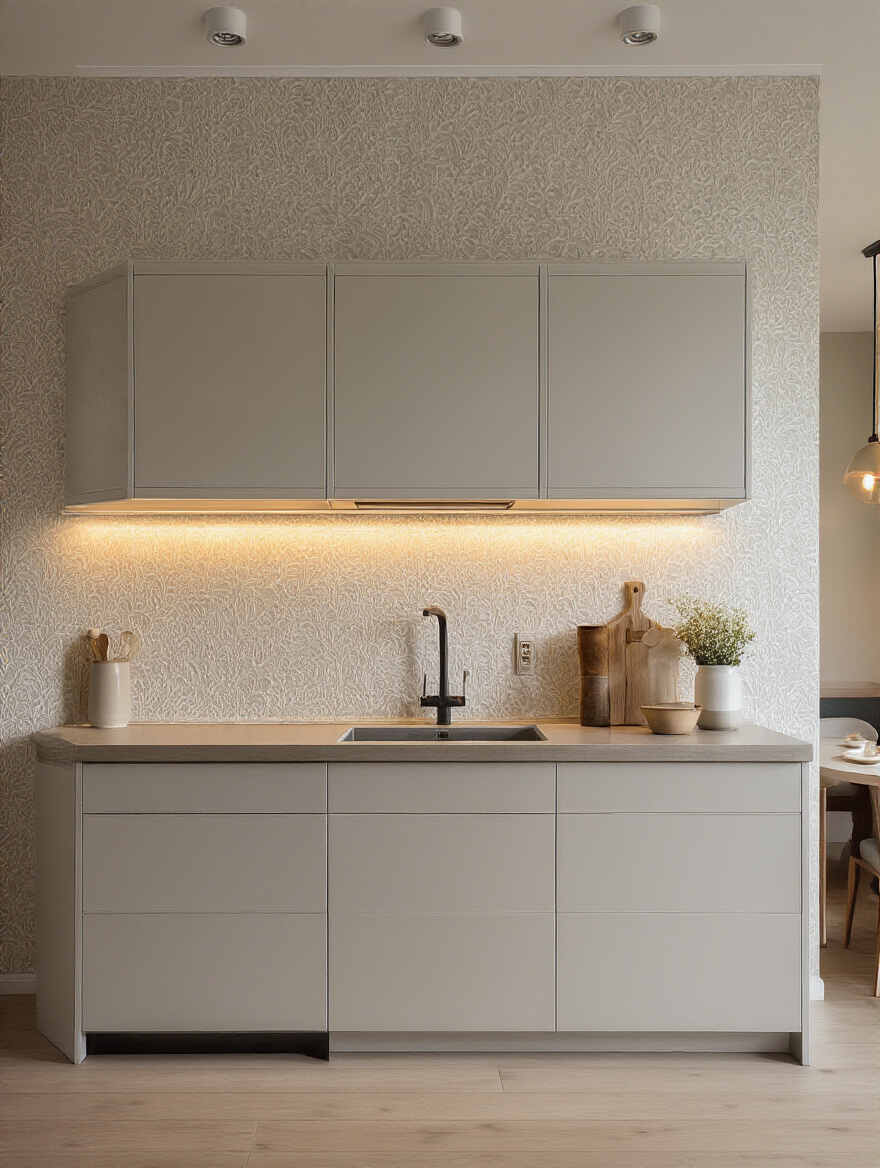
For textured wallpapers, like grasscloth or embossed patterns, under-cabinet lighting is your best friend. It casts a soft glow upwards, raking across the surface and highlighting all the beautiful, subtle texture that would otherwise be lost. Put everything on a dimmer. That way, you can have bright, functional light when you’re cooking, and then dim it down in the evening to create a soft, ambient glow that makes your wallpaper the star of a moody, beautiful scene. You aren’t just lighting a room; you’re sculpting with light.
You’ve sculpted the light, and now you must sculpt the space on your shelves. They are no longer just for storage.
13. Integrating Open Shelving and Decor Without Overwhelming
Please, I beg of you: do not spend all this time creating a beautiful wallpaper backdrop just to cover it up with clutter. Open shelves against wallpaper are not for your mismatched mug collection and half-empty bags of quinoa. They are curated displays. The most important concept in any art gallery—and on your shelves—is negative space. The wallpaper needs room to breathe.
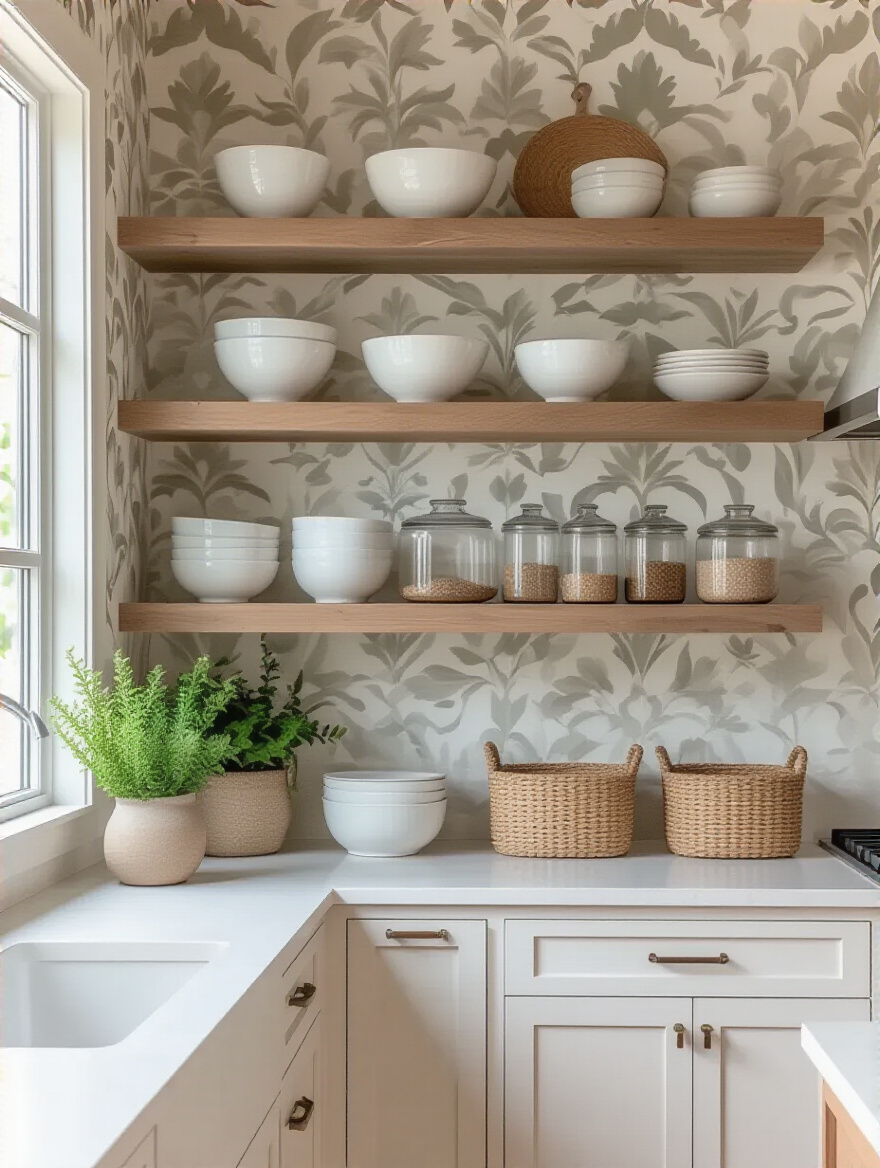
Follow the curator’s rule: group items in odd numbers (usually three or five), vary their height, and mix textures. A stack of three white ceramic bowls, a small green plant, and a single wooden cutting board. That’s it. That’s a beautiful composition. Pull colors from your wallpaper for the items you display. If your paper has a lovely blue detail, find a set of blue glasses to display. It makes the entire vignette feel intentional and connected, turning your shelves into a living still life.
In larger spaces, your wallpaper can do more than just beautify a wall—it can build one, metaphorically speaking.
14. Using Wallpaper to Define Zones in Open-Concept Kitchens
In an open-concept home, the lines can get blurry. Where does the kitchen end and the dining room begin? Wallpaper is the most elegant solution to this problem. You can use it to create a “room” without building a single wall. Wrapping the walls around your dining table and chairs in a distinct wallpaper instantly carves out an intimate, dedicated dining zone. It says, “This is a special place.”
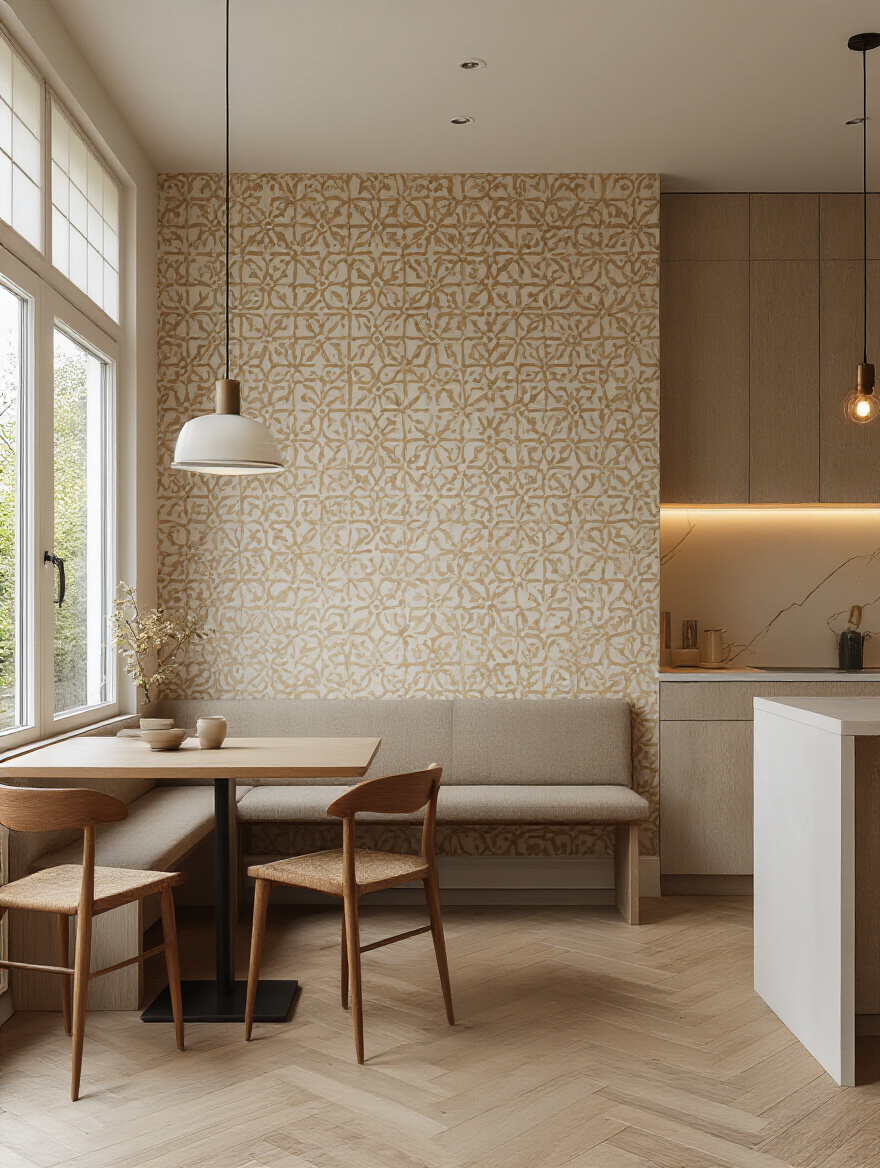
I recently did this for a client with a long, open kitchen-living area. We built a simple banquette bench along one wall for casual dining. By applying a beautiful, mural-like wallpaper just in that nook—from the bench up to the ceiling—we created a destination. It’s now the coziest, most defined spot in the entire open space, and it didn’t require any construction. The wallpaper acts as a visual anchor, giving the zone its own identity and purpose.
Longevity and Smart Care for Your Kitchen Wallpaper
You’ve invested time, money, and creativity into this project. Now, you need to protect that investment. Like any work of art, your wallpaper requires a bit of thoughtful care to keep it looking pristine for years to come. Fortunately, it’s easier than you think.
15. Everyday Cleaning Regimens for Different Wallpaper Types
This is simple. If you chose a durable vinyl for your kitchen (which I hope you did!), a wipe-down with a damp sponge and a tiny bit of mild dish soap is all you need for most spills. For anything greasy, a dedicated degreasing spray designed for kitchens works wonders. Just spray it on a cloth, not directly on the wall.
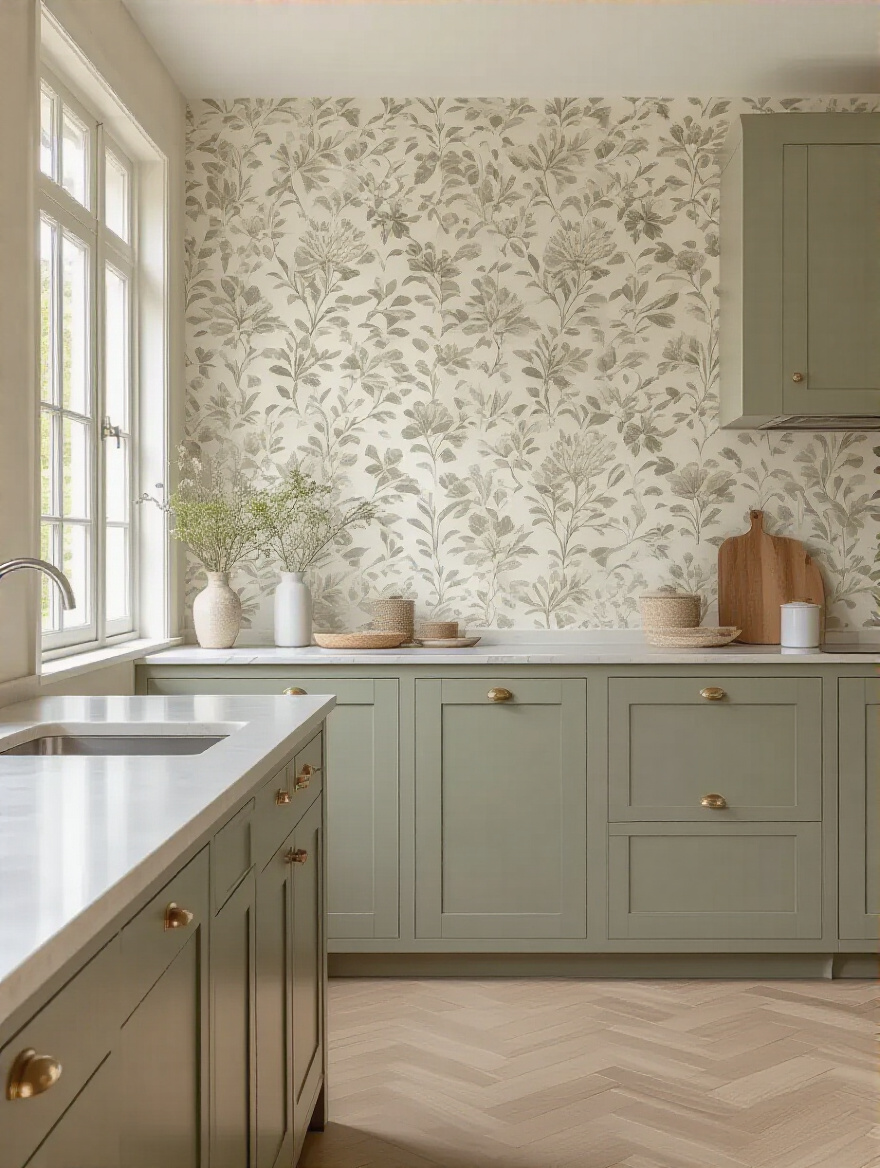
For more delicate, non-woven, or textured papers, stay away from water as much as possible. A light dusting or a gentle pass with the brush attachment of your vacuum is your best bet. If you get a small, non-oily smudge on a non-washable paper, you can sometimes lift it with a white art gum eraser—the kind you find in an art supply store. The key is to be gentle and always test your cleaning method on a hidden spot first.
But what happens when prevention fails and you find yourself facing an actual issue? Don’t panic. Most common problems have simple solutions.
16. Tackling Common Issues: Peeling, Stains, and Damage Repair
The most common issue you’ll face in a kitchen is a seam that starts to lift slightly due to humidity. This is not a catastrophe. This is a five-minute fix. Go to a hardware store and buy a small tube of “seam adhesive.” Squeeze a tiny bead of it under the peeling edge, press it down firmly with a seam roller or even the side of a smooth glass, and wipe away any excess with a damp sponge. Done. Ignoring it is what turns it into a real problem.
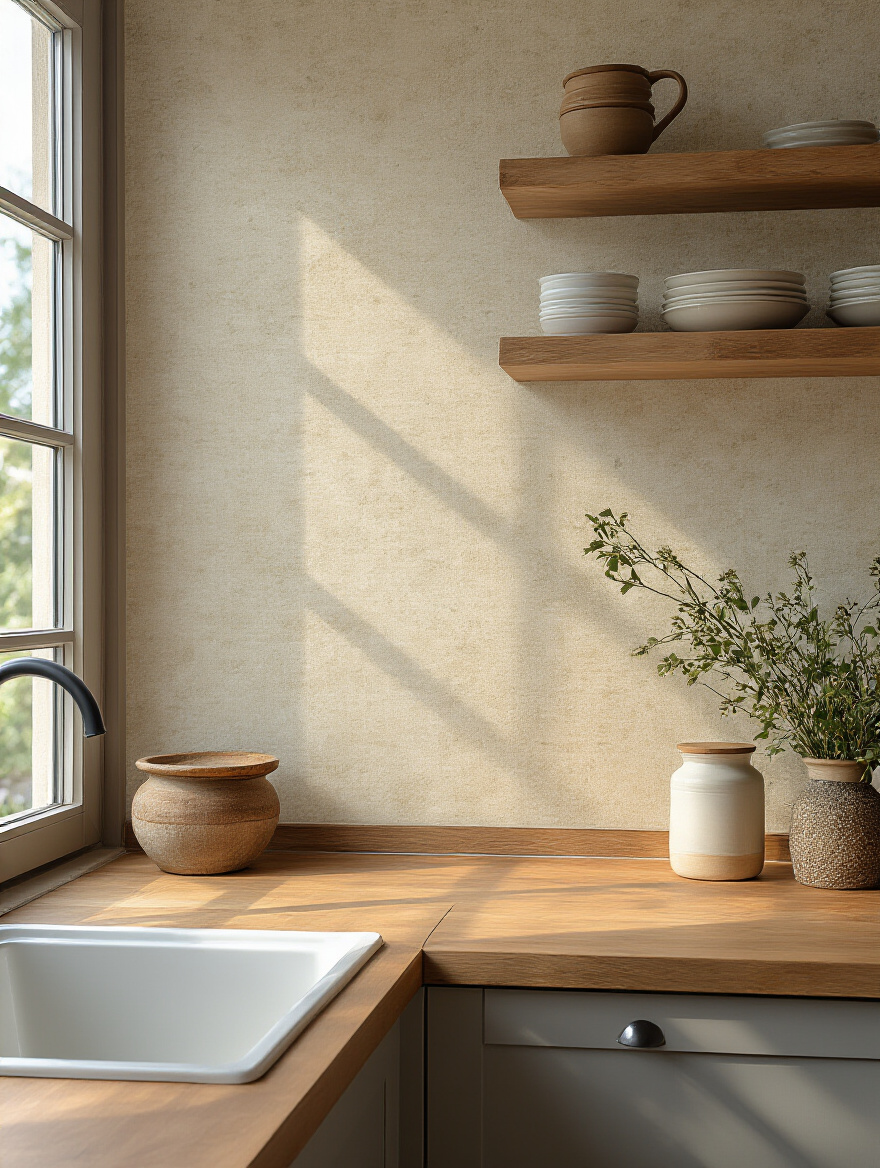
If you get a small tear or nick in the paper, this is why you saved that extra roll! Cut a piece of the new paper that is slightly larger than the damaged area and perfectly matches the pattern. Hold it over the tear and, using a ruler and a sharp utility knife, cut through both the patch and the damaged paper on the wall. Peel away the damaged section underneath, apply a bit of paste, and pop your perfectly cut new piece into place. It will be invisible.
You can also ensure your wallpaper feels perpetually fresh not just through care, but through creative curation of its surroundings.
17. Seasonal Refreshments: Updating Accessories to Match Your Wallpaper
One of my favorite things to do is to treat a wallpapered wall like a permanent exhibition that gets re-contextualized every season. This is the secret to never getting tired of your wallpaper. If you have a beautiful green botanical print, bring in fresh, bright yellow dish towels and a bowl of lemons for spring and summer. In the fall and winter, swap them for deep burgundy textiles, a wooden bowl of pomegranates, and warm copper accents.
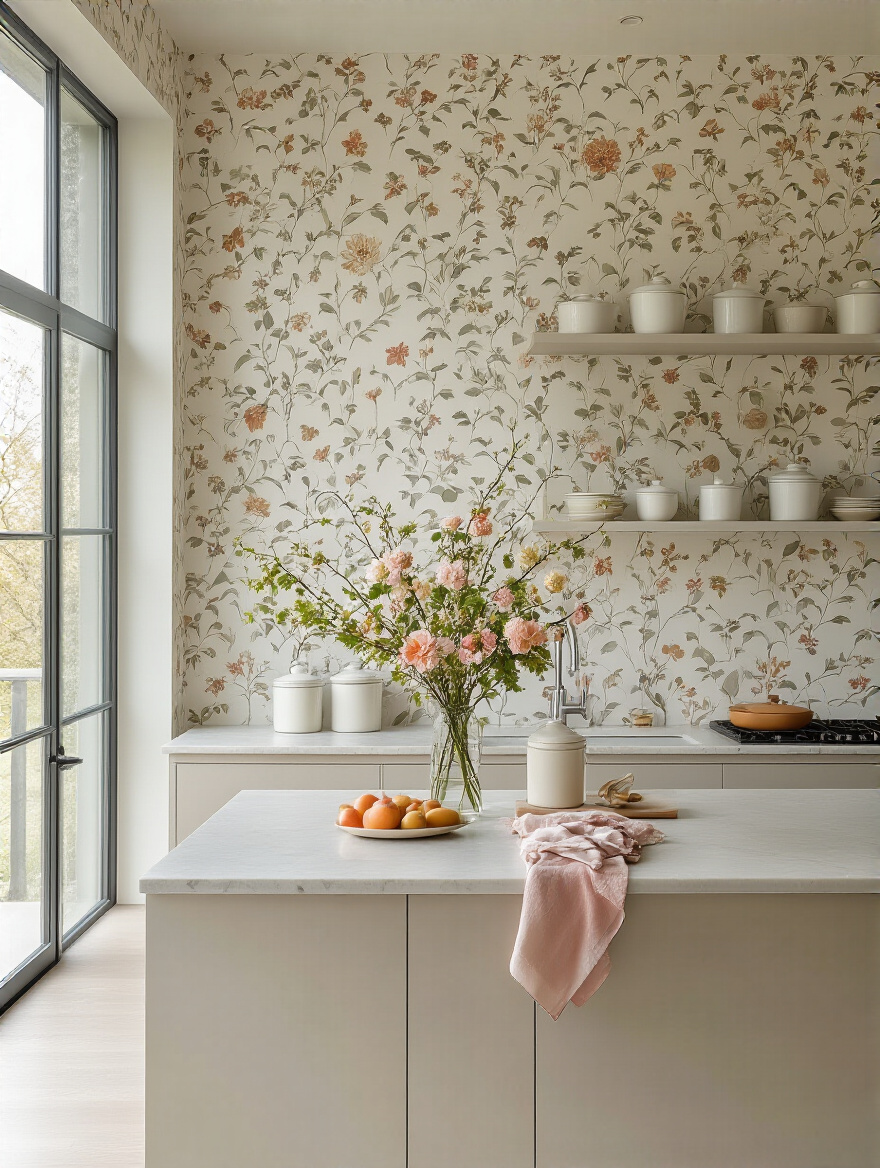
By changing the accessories around it, you highlight different colors and moods within the wallpaper itself. It feels like a completely refreshed space, but all you did was spend $50 on a few new tea towels and a vase. This keeps your kitchen feeling dynamic and alive, always in conversation with the art on the walls.
Finally, let’s wrap this up with a quick lightning round of what not to do. Avoid these common traps, and you’re golden.
18. Avoiding Common Mistakes That Shorten Wallpaper Lifespan
Don’t skip the primer. Don’t use the wrong adhesive—buy the one recommended for your paper and for high-humidity environments. Don’t use an abrasive sponge or harsh cleaner like bleach on any wallpaper, ever. And don’t ignore small problems. A tiny peeling corner can be fixed in 30 seconds. A giant peeling sheet that’s been collecting grease and moisture for six months cannot.
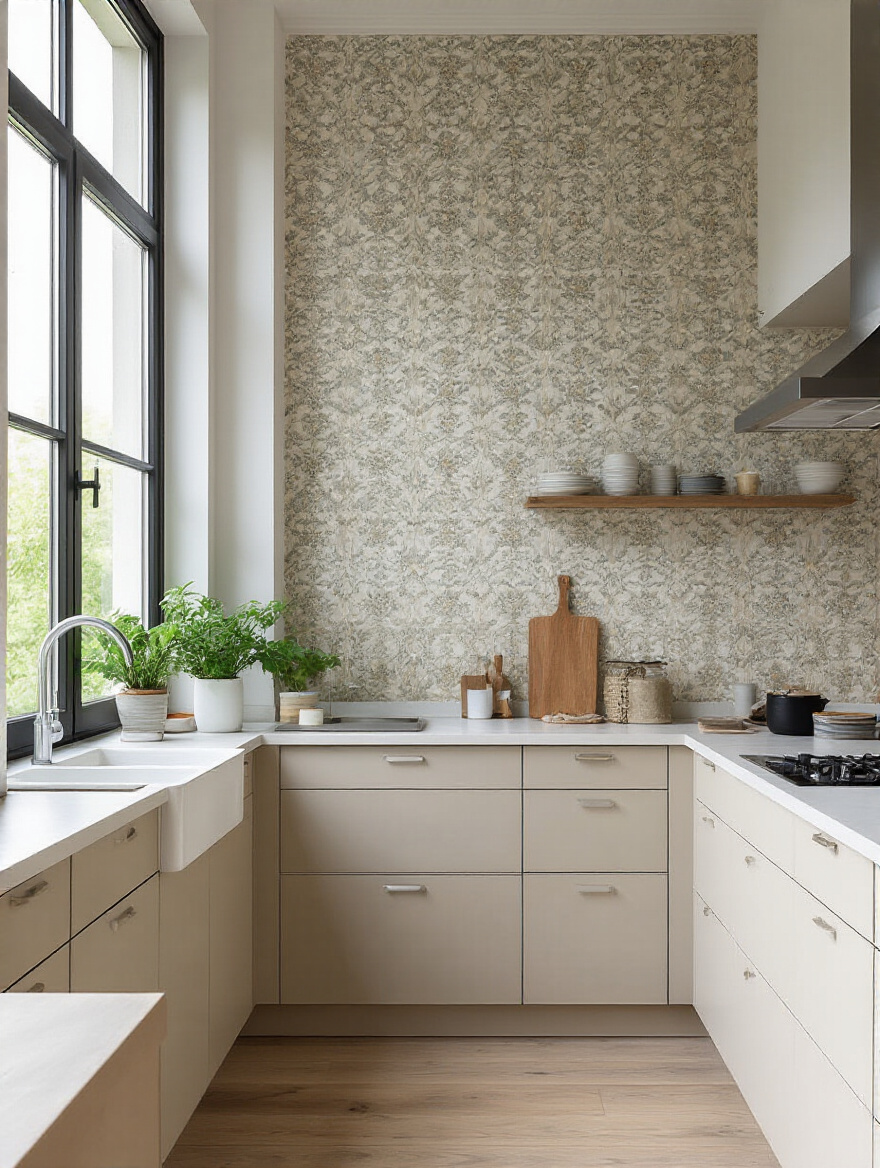
The biggest mistake is treating it like it’s just a wall. It’s not. It’s a piece of your home’s personality. It’s a design element you chose to bring joy and beauty into your daily life. Treat it with a little bit of respect, and it will reward you for years.
Conclusion
So, there you have it. The notion that kitchens must be bare and boring is officially dead. By choosing the right material, curating the placement, and thinking like an artist, your kitchen walls can become the most transformative feature in your home. It’s not about following rigid rules; it’s about understanding the fundamentals so you can confidently make bold, personal choices that reflect who you are.
Don’t be intimidated. Start by finding a pattern that makes your heart beat a little faster. Order a sample. Tape it to the wall and see how it feels. This is your gallery, your home. You get to be the curator. You have the vision and the knowledge to create a space that’s not just functional, but truly extraordinary—a work of art you get to live in every single day.
